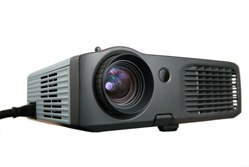Computer monitors and projectors
 If you stare at computer monitors for hours every day, you come to appreciate the benefits of having the right computer monitor for the job. It’s important everyone in your business has computer monitors which are clear, large and bright enough.
If you stare at computer monitors for hours every day, you come to appreciate the benefits of having the right computer monitor for the job. It’s important everyone in your business has computer monitors which are clear, large and bright enough.
For general use, you’ll almost certainly be looking at flat screen computer monitors. These have entirely replaced old-fashioned, bulky cathode ray tube (CRT) computer monitors.
In addition to flat screen computer monitors, your business may also use computer projectors in meeting rooms or to give presentations.
Pick the right computer monitors
You can buy desktop PCs with or without computer monitors. The flat screen computer monitors included with PCs are typically adequate, but basic. Over the long-term it can be wise to purchase more suitable computer monitors separately, then retain them when you next upgrade your computers.
It is possible to use two computer monitors with one computer. This is often called ‘dual screen’ or ‘dual computer monitors’. It can improve productivity by giving you more space to work in, but having two computer monitors means you will require a separate connection for each of the computer monitors.
It can be easier and cheaper to achieve the same amount of screen space with a single, large computer monitor. Indeed, large computer monitors are beneficial to people whose jobs require them to switch frequently between computer programs or keep several files open at once.
Features of flat screen computer monitors
Flat screen computer monitors are also called LCD or TFT monitors. There are a few key things to look for when choosing them:
- Size. Larger computer monitors are easier to work with. Computer monitors with a 19” screen (measured diagonally) should be the minimum, but larger sizes are increasingly affordable. If you can afford it, a 27" screen will give you an impressive space to work in. Most flat screen computer monitors have widescreen proportions.
- Resolution. This measures what you can fit onto the computer monitor. A higher resolution is generally better (look for computer monitors with 1,440 x 900 pixels or more), but be wary of small computer monitors that have high resolutions. This can result in text which is difficult to read.
- Adjustment. Look for computer monitors which can be easily swivelled, tilted and adjusted for height. Some computer monitors can even rotate between portrait and landscape format, which is handy for editing documents.
- Image quality and contrast. Computer monitor manufacturers quote contrast ratios and may talk about image clarity. Ignore these claims. The only way to reliably judge the quality of computer monitors is to compare them.
- Touchscreen capabilities. Some monitors are touch-sensitive, allowing you to control your software by tapping, swiping and dragging on the screen.
If possible, trial new computer monitors in your business before purchasing. Make sure you test them in bright light, as some computer monitors have shiny, reflective coatings. This can be a real strain for people who have to use them all day.
Flat screen computer monitors can be bought for as little as £70, but expect to pay £100 for a usable, mid-range display and anything upwards of £250 for a touchscreen monitor.
Computer projectors
Computer projectors are an alternative to computer monitors and allow you to project a large image onto a blank wall or screen. Projectors are useful for presentations and meetings and can often be connected up to DVD players or digital TV boxes too.
Projectors come in two main types: LCD (liquid crystal display) projectors and DLP (digital light processing) projectors. It doesn’t really matter which you choose – they both do the same job.
As with computer monitors, check the resolution of computer projectors carefully. Projectors with a resolution of 1024 x 768 pixels should be adequate for presentations, but aim higher if possible. Look for projectors that are ‘HD ready’ if you want to show high definition video.
The brightness of computer projectors is measured in ‘ANSI lumens’. Look for 1,200 ANSI lumens for projectors that will work well in a dim room, 2,000 for projectors that will be used in a normal office environment, and 3,000 for projectors that you’re planning to use in brighter light.
Budget £400 for a good, mid-range computer projector. Small, portable projectors may be more expensive.
More about computer screens and accessories:
Find more articles, videos and tools about computer screens and projectors in the Resources box on the right.




